RAIN and CRA Identify Benefit of Tiling Infrastructure for Algoma
Posted: March 13, 2014
Categories: News from Sustain Members
 The Rural Agri-Innovation Network (RAIN), a Sustain Ontario Member, worked in partnership with Conestoga-Rovers & Associates (CRA) to complete an agricultural engineering analysis and development strategy, called the Agricultural Tile Drainage and Storage Study for Algoma District, in 2013. for The study builds on RAIN’s research and development mandate to identify barriers (such as a lack of infrastructure for Algoma producers) and viable solutions for growing the agricultural sector in the region.
The Rural Agri-Innovation Network (RAIN), a Sustain Ontario Member, worked in partnership with Conestoga-Rovers & Associates (CRA) to complete an agricultural engineering analysis and development strategy, called the Agricultural Tile Drainage and Storage Study for Algoma District, in 2013. for The study builds on RAIN’s research and development mandate to identify barriers (such as a lack of infrastructure for Algoma producers) and viable solutions for growing the agricultural sector in the region.
The Agricultural Tile Drainage and Storage Study for Algoma District looked at locations of currently drained lands in Algoma, and then ranked the priority of lands which would most benefit from tiling infrastructure. A cost-benefit assessment associated with installation was conducted, including options for reducing costs such as funding or cost-share strategies. The study also looked at Algoma’s capacity for crop storage infrastructure, such as grain bins and silos, grain dryers and dry storage facilities.
Known for its clay-based soils, one impediment faced by Algoma district farmers is insufficient investment in tile drainage. Drainage infrastructure allows for the water level on or in the soil to be controlled to enhance agricultural crop production. There are two systems: surface and subsurface, the latter of which is called a tile system. All parts of a tile system, except for the outlet, are located below ground level and provide better drainage than a surface system, allowing roots to grow stronger and deeper. In combination with agricultural best practices, tiling systems are especially beneficial for field crops.
“Tile drainage is one of the biggest tools farmers could use to increase not only yields, but the viability and sustainability of their farming business. This is an excellent investment for the future of Algoma,” said Murray Cochrane, Secretary and Treasurer of Algoma Soil and Crop Improvement Association.
Compared to southern Ontario farms, many fewer Algoma district farms have tiling systems. Barriers to the infrastructure in the region may include: installation costs, access to fewer licensed local installers, and higher investment costs per acre when compared to southern Ontario, because Algoma farmland is not valued as highly per acre.
Improving land drainage and storage opportunities are essential in growing the Algoma district agricultural sector and local economy. The study has identified the need to invest $6,500,000 in this infrastructure. In order to increase the amount of tiled land in Algoma, RAIN will use the results of this study to help fund part of the tiling installation costs for farmers.
For more information on this study, please contact Katie Filion, RAIN Market Development Specialist, at 942-7927 ext. 3024 or kfilion@ssmic.com.
This project was supported financially through RAIN (a project of the Sault Ste. Marie Innovation Centre (SSMIC) and NORDIK Institute) the Northern Ontario Heritage Fund Corporation and FedNor. Significant support was also provided through rural municipalities and grower organizations, including the Algoma Soil and Crop Improvement Association.

